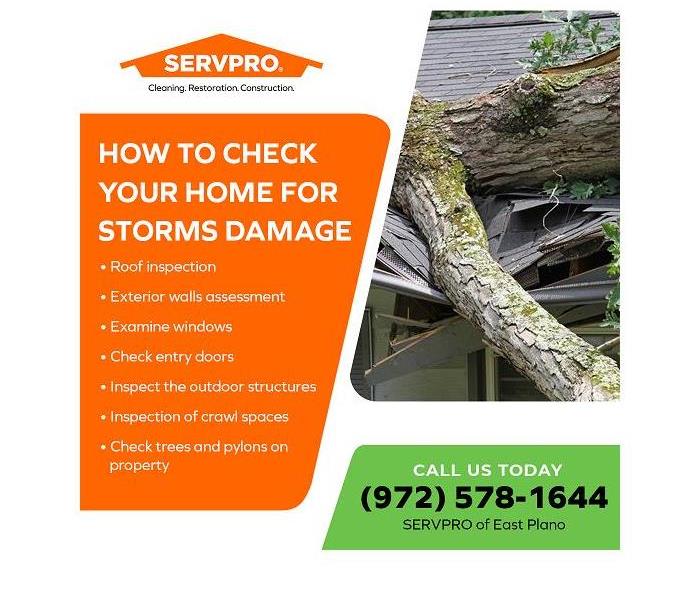Flood Restoration 101: How to Check Your Home for Storm Damage
10/9/2022 (Permalink)
Blog Summary: SERVPRO of East Plano explains how to check for storm damage in homes.
Homes and businesses across the US are increasingly at risk of flood damage in comparison to the past. Flooding is a very distressing experience and flood damage can be devastating for both families and businesses. Taking immediate action to limit flood damage is necessary for safety and to reduce additional costs incurred for worse damage.
Flood damage can be caused by severe thunderstorms, heavy rainfall, hurricanes, and adverse weather conditions. Flood water can rise due to remote events like snowcaps melting off mountains that are far away. Flooding can happen from causes within a building like broken pipes, faulty appliances, sewer backups, etc.
Storms are any type of disturbance in the environment or atmosphere that strongly contribute to severe weather. Storms are of different types and can include thunderstorms (heavy wind, thunder, lightning, hail), snowstorms, rainstorms, strong winds (cyclones, hurricanes, tornadoes), etc.
The process of removing water, decontaminating the area affected, and making the building or property safe enough to carry out repairs, is flood restoration. Flood water is considered to be contaminated, and hazardous. People and animals must be kept away from exposure to it. This is why flood restoration is a job for a professional water damage restoration company that is equipped to handle storm damage and flood restoration. SERVPRO of East Plano has highly-trained professionals capable of providing flood restoration services in Parker, TX. Some ways to check for storm damage are shared in this article by SERVPRO® of East Plano for the benefit of homeowners who need flood restoration.
Stormy weather can bring heavy rains, strong winds, and lightning which are all capable of damaging property. Damaged windows and roofs are very common after storms, and can lead to water damage. Even when a home appears intact after a storm, it is better to check for hidden storm damage. This will help start storm damage repair as early as possible, which is better for safety and keeping costs low. Storm damage can be identified by checking the following:
1. Roof Inspection
Roofs are at high risk for damage during storms. Heavy rains, winds, and airborne objects like tree branches, can all cause damage to this structure. The roof must be checked for signs of storm damage like broken, curling, or missing shingles, gaps between tiles, debris like leaves or twigs in the gutters or downspouts, and damage to the chimney.
2. Exterior Walls Assessment
Walls must be carefully examined for signs that indicate storm damage that is not obvious. These include cracking that radiates from a point in a spider pattern, splitting or breaking, chipping of paint, small holes or dents, and discolored, damaged, or missing sidings. The walls must be checked on the inside and outside for damp patches.
3. Examine Windows
Windows can be shattered in storms causing interior damage by the broken glass and allowing water to enter the building. Though at a casual glance windows may not appear broken, they must be examined meticulously for small cracks, loose glass panes, and damaged window frames that have small dents or cracks. Sturdy gloves can be used when inspecting windows to avoid injury. Boarding up windows temporarily with plywood will reduce further damage and protect the interiors from natural elements.
4. Check Entry Doors
Entry doors can be subjected to strain by heavy winds and water flow. This can cause them to fall off their hinges, break, or develop cracks and holes. A damaged door will expose the home to water and other unwanted elements.
5. Inspect The Outdoor Structures
External wooden structures like decks, porches, and fences can sustain storm damage. The area surrounding the structures must be checked for dampness and water pooling. The structures must be checked for cracking, chipping, and other damages like warped boards. Check for missing planks, railings, steps, etc. Loose boards can be secured with screws and debris cleared.
6. Inspection Of Crawl Spaces
Crawl spaces can harbor flooding and excess moisture after a storm. If left unattended, this can cause costly damages. Roof leaks, leaky doors, pipe leaks, and condensation can all allow water to enter crawl spaces. Check for signs like musty smells, pests, saggy or sloped floors, etc., in the crawl spaces. These indicate flood restoration is needed.
7. Check Trees and Pylons On the Property
Pylons on the property and nearby must be checked for damage caused by the storm that can lead to a power outage. If broken cables or tilting pylons are noticed, the utility office must be notified. Trees must be checked for loose branches that can cause danger.
Minor repairs may be handled by homeowners. But if there are signs like cracking on walls or signs of insulation damage that allow moisture in, experts will need to be called. If flooding has occurred, flood restoration needs to be done by professionals who have the experience and skills needed to handle it swiftly and efficiently. For storm damage repair in Parker, TX, homeowners or business owners can contact SERVPRO of East Plano. Whether the storm damage is minor or severe, this property damage restoration company is equipped and experienced enough to provide flood restoration services. They belong to the SERVPRO® network which is the number one choice in the restoration industry. SERVPRO of East Plano has highly trained restoration technicians available 24/7. They respond to emergencies like storm and flood damage immediately and help speed up the insurance process for customers.





 24/7 Emergency Service
24/7 Emergency Service
